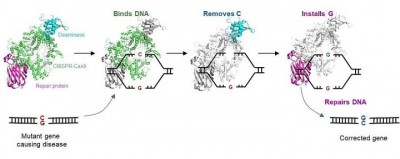Singapore, March 14 : A team of researchers has developed a CRISPR-based gene editor, C-to-G Base Editor (CGBE), to correct mutations that cause genetic disorders.
One in seventeen people in the world suffers from some type of genetic disorder.
“The CGBE gene editor is a ground-breaking invention that for the first time, directly converts C to G in genes, which potentially opens up treatment avenues for a substantial fraction of genetic disorders associated with single-nucleotide mutations,” said author Chew Wei Leong, Senior Research Scientist at Genome Institute of Singapore.
The most common mutation by far is the single-based substitution, in which a single-base in the DNA (such as G) is replaced by another base (such as C) according to the study, published in Nature Communications.
Countless cystic fibrosis patients worldwide have C instead of G, leading to defective proteins that cause the genetic disease. In another case, replacing A with T in haemoglobin causes sickle cell anaemia.
To fix these substitutions, the team invented a CRISPR-based gene editor that precisely changes the defective C within the genome to the desired G.
This C-to-G base editor (CGBE) invention opens up treatment options for approximately 40 per cent of the single-base substitutions that are associated with human diseases such as the aforementioned cystic fibrosis, cardiovascular diseases, musculoskeletal diseases, and neurological disorders.
The CGBE editor advances the widely adopted CRISPR-Cas9 technology to enable molecular surgery on the human genome. The CRISPR-Cas9 technology is routinely used to disrupt target genes, but it is inefficient when a precise change to particular sequences is desired.
The CGBE editor resolves a key aspect of this challenge by enabling efficient and precise genetic changes.
CGBE consists of three parts — a modified CRISPR-Cas9 will pinpoint the mutant gene and focus the entire editor on that gene; a deaminase (an enzyme that removes the amino group from a compound) will then target the defective C, and mark it for replacement, and; finally, a protein will initiate cellular mechanisms to replace that defective C with a G.
This enables a previously unachievable direct conversion from C to G, correcting the mutation and, consequently, treating the genetic disorder.
Disclaimer: This story is auto-generated from IANS service.

